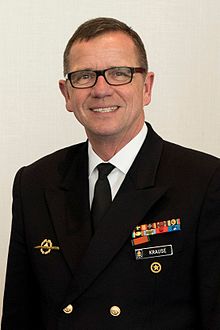commander
A commander (in short: Kdt also Kdt. Or K ) is the leader of a military facility, a vehicle, an aircraft or a watercraft and, outside of Germany, a military association . In some civil organizations, too, the heads of certain institutions are called commanders.
Use in the military
Germany

In Germany, the leaders of interconnected military installations and systems in the Bundeswehr are referred to as commanders. These include warships , aircraft and vehicles as well as command posts , barracks and military training areas . In command authorities there may be a "commandant headquarters" who leads the non-commissioned officers and crews of the staff in terms of disciplinary law. In the Bundeswehr, however , the leaders of military units from battalion upwards are called commander , of units “chief” and of sub-units “leader”, in each case with intent according to the troop unit (e.g. battalion commander , company commander and platoon leader ).
The commander of a warship has sole responsibility for his ship and its crew when traveling and in war. As a command signal, he wields a command pennant in the mast of his ship and is entitled to the honors from the side and front . In addition to his naval and military duties, he is responsible for diplomatic or official duties abroad as a representative of the Federal Republic of Germany. The rank of the ship commander depends on the size and task of the respective ship. He varies from the lieutenant captain (for a minesweeper ) to the sea captain (the training ship Gorch Fock ). The commander of the multi-purpose landing craft ( Lachs ) occupies an exceptional position , who in the rank of captain is not an officer, but a sergeant with portepee . The civil auxiliary ships of the Bundeswehr, however, are not led by a commander, but by a captain .
In the Navy, commanders, including former commanders, wear the commander's special badge . When the commanding officer is active, it is worn on the right side of the chest above the breast pocket. Former commanders wear it on the left side of the chest under the name tag.
Austria and Switzerland
In Austria and Switzerland the leaders of units , associations and large associations are also called commanders. The word commander is not used there. Commanders are officers , usually captain and above , who have completed additional courses in leadership and tactics in order to exercise their function .
A commander commands a unit (depending on the country at a lower level such as in Austria the group or in Switzerland starting from the company level to the brigade or territorial region level), a military system (e.g. firing commander in the artillery ) or a fixed military facility (For example, as the site commander of a military training area or barracks commander ) and is responsible for it.
history
In addition to the commanders of warships, the commanders of a fortress ( subordinate to a military governor for fortresses of the first rank ), an open city or a military training area were referred to as commanders in the German Reich . In contrast to the governor, the fortress commander never had higher, but only lower jurisdiction . If he was under a governor, his duties were limited to garrison service. Subordinate to him was the place major .
In the Austro-Hungarian Austro-Hungarian Army , every leader of a military unit (regardless of size) was designated as a commander.
Use in the civil sector
Even in civil organizations that are or were structured according to the military model (e.g. fire brigade ), units are led by commanders.
Since the introduction of the JAR-FCL , the pilot in charge of an aircraft has been referred to as the commander.
See also
Web links
Individual evidence
- ↑ Abbreviations for use in the Bundeswehr (PDF) Federal Minister of Defense. January 19, 1979. Retrieved June 13, 2019.
- ↑ Suit regulations for soldiers in the Bundeswehr. (PDF; 11.6 MB) In: https://www.reservisten.bundeswehr.de/ . Inner Guidance Center , October 1, 2019, accessed on October 11, 2019 (No. 559).
- ↑ Suit regulations for soldiers in the Bundeswehr. (PDF; 11.6 MB) In: https://www.reservisten.bundeswehr.de/ . Inner Guidance Center , October 1, 2019, accessed on October 11, 2019 (No. 560).
